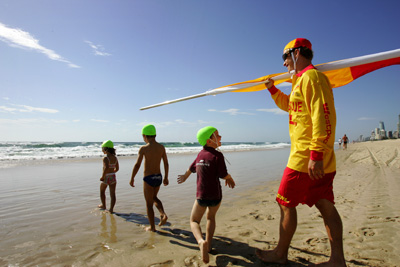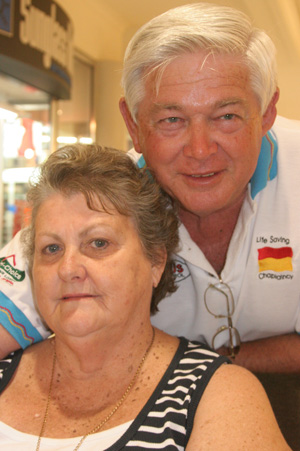
In an article first published in The Salvation Army’s Warcry magazine, ANDREA REDFORD talks to those serving on the frontline this summer…
Lifesavers are a heroic breed. Dedicated, fit, vigilant and brave, this army of (mostly) volunteer patrollers numbers more than 35,000 in Australia.
Surf Life Saving Australia (SLSA) and its state centres provide patrol services on 400 beaches around Australia’s 36,735 km coastline.

SWIM BETWEEN THE FLAGS: More than 35,000 mostly volunteer surf lifesavers patrol Australia’s beaches. PICTURE (and index page image): Surf Life Saving Queensland.
SLSA is Australia’s major water safety and rescue authority and one of the largest volunteer organisations in the country. Their mission: to provide a safe beach and aquatic environment throughout Australia.
In meeting their mission, SLSA volunteers spend hours training in surf skills and first aid techniques, patrolling and educating the beach-going public, as they live up to the association’s motto of ‘vigilance and service’.
One man dedicated to the welfare of the swimming public at his local beach, as well as the emotional and spiritual wellbeing of the lifesavers themselves, is Terry Legg.
Mr Legg serves as both lifesaver and club chaplain at Southport Surf Life Saving Club on Queensland’s Gold Coast.
The 68-year-old retiree has been a lifesaver for more than 40 years, first serving in the ‘red and yellow’ in 1953. He has patrolled “on-and-off” at a number of Queensland beaches ever since.
In 1995, Mr Legg was invited to help organise a church service at the National Surf Life Saving Championships. Following this, Terry and SLSA life member Phil McGibbin approached the association and proposed a chaplaincy service to the clubs.
SLSA approved the proposal and Mr Legg established Life Saving Chaplaincy (LSC), in association with Christian organisations Athletes in Action and Campus Crusade, in 1997.
Mr Legg now coordinates the work of 13 chaplains in surf life-saving clubs around the country.
“There are plenty more clubs who would like chaplains,” he says. “However, finding someone who can fit into a surf club is pretty difficult – it’s a culture all of its own. It’s better if we can find lifesavers who are also Christians who are prepared to take on the role.”
Amanda Best, 29, has been chaplain at Tugun Surf Life Saving Club on the Gold Coast for the past four years.
While Ms Best is not actively patrolling at the moment, her background in, and understanding of, lifesaving is strong.
“I realised that for many people, being at their lifesaving club every weekend is like church for them – they have a desire to be part of something bigger than themselves.
“Since the majority of lifesavers don’t get to church on Sundays, I decided I wanted to be the church to them,” Ms Best says of her decision to become the club’s chaplain.
“I have had long-term relationships with many of the club members and the majority have been very welcoming of me as their chaplain – in fact, they encourage it,” she says, “and I have found it very rewarding to build relationships with people who have not only changed my life but, I believe, influenced them for good.”
But she admits, the role is not without its challenges.
“Some people resist the obvious nature of a spiritual influence in their teammates,” she says. “But I don’t need to push or defend [my beliefs], I just continue to love at all costs.”
Despite years as a ‘clubbie’, Mr Legg was met with a fair share of suspicion when he arrived at Southport in 1997.
“Years later I found out that for my first four years at the club some of the older committee members watched me every weekend just to make sure I was up to no mischief,” he says.
However, 11 years later, Mr Legg (along with wife Maureen) has well and truly established a welcome presence at the club and has carved out a niche role for himself at Southport.
“We’ve got 170-odd patrolling members at Southport, and about 3,000 associate (non-patrolling) members,” he explains.

DEDICATED TEAM: Terry and Maureen Leg
“Hanging around the club on Saturdays and Sundays is a must. Especially between about 11 am and 1 pm – that’s when the patrols change over. I go down to the beach and speak to each member on patrol.
“If anybody wants to talk about any issues, I make appointments with them during the week. There have been times when I’ve helped with services or scattering ashes when a member’s loved one has died,” he says.
“Overall, though, being a chaplain is about just being with people and sharing and listening to them talk about anything they want to.”
As CEO of Surf Life Saving Queensland, Tony Scanlan says chaplains in SLSA clubs fit well with the association’s sense of duty to its members.
“The organisation believes we have a broader responsibility to our members than just on the beach and the chaplaincy service is an opportunity to offer a different avenue of support to them,” he says.
“Our members have someone to talk to about spiritual issues or issues that confront them as part of everyday life.”
However it’s at times of crisis when the support of the chaplains comes to the fore, says Mr Scanlan.
“The chaplaincy service is most valuable when our members have to face the reality of rescues that are distressing in nature, especially when the patient does not survive. The chaplains provide a positive source of counselling and support our members to cope.”
Mr Legg agrees, saying that his support can be required as a result of an incident on patrol.
“Thankfully, Southport SLSC hasn’t lost anyone between the flags for 84 years, but that doesn’t mean no trauma exists,” he says. “There are injuries sometimes.
“I remember the first trauma I attended as chaplain. We had one swimmer go missing. He got barrelled by a big wave and got washed probably 40 or 50 metres down the beach. He was so exhausted he went straight home, but didn’t let anyone know he was OK.
“He was reported as missing. Three days later he went to the police station and said, ‘I think I’m the guy you’ve been looking for’.
“Everyone was relieved he was OK, but there was still trauma for three days for the lifesavers who searched for him and couldn’t find him.”
One tradition Mr Legg has established at Southport is the annual church service to pray for a safe lifesaving season ahead. This year’s service, held in early November and attended by 80 people including SLSA hierarchy, local councillors and federal government members, was a spectacular sight.
“Celebrations Afloat, a business here on the Gold Coast, generously donated the use of their floating chapel. We left the dock and motored to a little bay nearby with safe anchorage, had the half-hour service, then came back home and docked.
“The positive feedback I’ve had is just awesome. It was a great time. All these ‘clubbies’ who generally don’t darken the door of the church attended.”
With Mr Legg kept so busy behind the scenes at the club, does he still get a chance to return to his first love and patrol the beach?
“Oh yeah,” he says, enthusiastically. “That’s the highlight, although I’m getting old and fat and have more trouble meeting the physical training requirements each year.
“I’ve always loved the beach. I’m not the best surfer in the world but I just love getting out there. There’s an enormous feeling of freedom being in that part of creation.
“God made the ocean’s edges shallow, after all – He expects us to use it,” he laughs.
Mr Legg’s affection and regard for lifesavers run deep.
“There’s a great movement in Australia in surf-lifesaving. They’re a group of dedicated people and the majority are volunteers.
“So many lifesavers understand Biblical principles, such as ‘There is no greater love than to lay down your life for another’.”
– Amanda Best
“So whenever they’re down the beach, they’re volunteering and are prepared to put their lives at risk – a calculated risk – to rescue others.
“As soon as anybody puts up their hand, it’s not a question of ‘Will we save them?’ but ‘How do we go about doing it?’,” he says.
With a belief in God and commitment to lifesaving both fundamental aspects of their lives, neither Mr Legg nor Ms Best can resist drawing a parallel or two.
“So many lifesavers understand Biblical principles, such as ‘There is no greater love than to lay down your life for another’,” says Ms Best.
“But who’s willing to lay down their life for the lifesavers? They need people who care about them, pray for them, and strengthen and support them behind the scenes so that they can faithfully serve on our beautiful beaches and keep communities, families and individuals safe.”
Mr Legg believes many aspects about the salvation Jesus offers resonate strongly with lifesavers.
“They engage in a similar activity every day,” he says.
“When someone is out in the water and needs help, they don’t get asked what race, colour or creed they are – it doesn’t matter. If someone needs help, they’re brought back in and that’s directly how Jesus saves.”
~ www.lifesavingchaplaincy.com
~ www.slsa.asn.au
This article was first published in the Salvaltion Army publication, Warcry.





